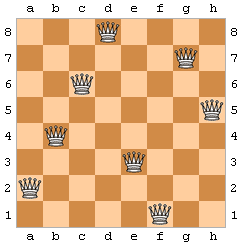Solution to the n Queens Puzzle
| Time Limit: 1000MS | Memory Limit: 131072K | |||
| Total Submissions: 4006 | Accepted: 1466 | Special Judge | ||
Description
The eight queens puzzle is the problem of putting eight chess queens on an 8 × 8 chessboard such that none of them is able to capture any other. The puzzle has been generalized to arbitrary n × n boards. Given n, you are to find a solution to the n queens puzzle.

Input
The input contains multiple test cases. Each test case consists of a single integer n between 8 and 300 (inclusive). A zero indicates the end of input.
Output
For each test case, output your solution on one line. The solution is a permutation of {1, 2, …, n}. The number in the ith place means the ith-column queen in placed in the row with that number.
Sample Input
8 0
Sample Output
5 3 1 6 8 2 4 7
Source
POJ Monthly--2007.06.03, Yao, Jinyu
大致题意:
N皇后问题:
在NxN棋盘内 纵、横、斜不重叠放置棋子,
当给定N (N ∈ [8, 300]) 时, 输出任意一种解法
解题思路:
采用构造法:
而目前网上流传的通解公式,则是为了便于编程,在坐标变换后得到的:
变换坐标后的求解公式如下:
① 当m mod 6 != 2 且 m mod 6 != 3时:
(A1):[2,4,6,8,...,m], [1,3,5,7,...,m-1] (m为偶)
(A2):[2,4,6,8,...,m-1], [1,3,5,7,...,m-2], [m] (m为奇)
② 当m mod 6 == 2 或 m mod 6 == 3时,
令 n= m / 2 (m为偶数) 或 n = (m-1)/2 (m为奇数)
(B1):[n,n+2,n+4,...,m], [2,4,...,n-2], [n+3,n+5,...,m-1], [1,3,5,...,n+1] (m为偶,n为偶)
(B2):[n,n+2,n+4,...,m-1], [1,3,5,...,n-2], [n+3,...,m], [2,4,...,n+1] (m为偶,n为奇)
(B3):[n,n+2,n+4,...,m-1], [2,4,...,n-2], [n+3,n+5,...,m-2], [1,3,5,...,n+1], [m] (m为奇,n为偶)
(B4):[n,n+2,n+4,...,m-2], [1,3,5,...,n-2], [n+3,...,m-1], [2,4,...,n+1], [m] (m为奇,n为奇)
上面有六条解序列:
一行一个序列(中括号是我额外加上的,以便辨认子序列)
第i个数为j,表示在第i行j列放一个皇后.
子序列与子序列之间的数序是连续关系(无视中括号就可以了), 所有子序列内j的递增值为2
代码:
#include <iostream>
#include <cstring>
#include <cstdio>
#include <algorithm>
#include <cmath>
using namespace std;
void queens_puzzle(int n)//n>=8
{
if(n%6!=2 && n%6!=3)
{
printf("2");
for(int i=4;i<=n;i+=2)
printf(" %d",i);
for(int i=1;i<=n;i+=2)
printf(" %d",i);
printf("\n");
}
else
{
int k=n/2;
if(n%2==0 && k%2==0)
{
printf("%d",k);
for(int i=k+2;i<=n;i+=2)
printf(" %d",i);
for(int i=2;i<=k-2;i+=2)
printf(" %d",i);
for(int i=k+3;i<=n-1;i+=2)
printf(" %d",i);
for(int i=1;i<=k+1;i+=2)
printf(" %d",i);
}
else if(n%2==1 && k%2==0)
{
printf("%d",k);
for(int i=k+2;i<=n-1;i+=2)
printf(" %d",i);
for(int i=2;i<=k-2;i+=2)
printf(" %d",i);
for(int i=k+3;i<=n-2;i+=2)
printf(" %d",i);
for(int i=1;i<=k+1;i+=2)
printf(" %d",i);
printf(" %d",n);
}
else if(n%2==0 && k%2==1)
{
printf("%d",k);
for(int i=k+2;i<=n-1;i+=2)
printf(" %d",i);
for(int i=1;i<=k-2;i+=2)
printf(" %d",i);
for(int i=k+3;i<=n;i+=2)
printf(" %d",i);
for(int i=2;i<=k+1;i+=2)
printf(" %d",i);
}
else
{
printf("%d",k);
for(int i=k+2;i<=n-2;i+=2)
printf(" %d",i);
for(int i=1;i<=k-2;i+=2)
printf(" %d",i);
for(int i=k+3;i<=n-1;i+=2)
printf(" %d",i);
for(int i=2;i<=k+1;i+=2)
printf(" %d",i);
printf(" %d",n);
}
printf("\n");
}
}
int main()
{
int n;
while(~scanf("%d",&n))
{
if(!n) break;
queens_puzzle(n);
}
return 0;
}